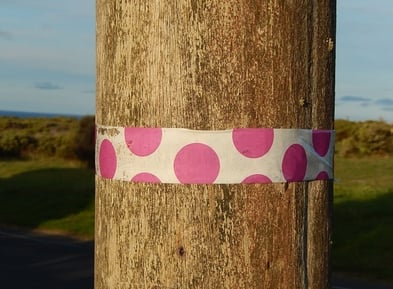Dealing With Painting Contractors: Spot Repairs (Touch-Ups)
Jeremy Holderness In this Dealing With Painting Contractors blog series we've discussed the Painting and Decorating Contractors of America (PDCA) industry standards for determining a Properly Painted Surface as well as Defined Levels of Surface Preparation. In this third and final installment we will address the PDCA's standard on Recommended Protocol for Spot Repairing Existing Finishes - AKA touch-ups.
In this Dealing With Painting Contractors blog series we've discussed the Painting and Decorating Contractors of America (PDCA) industry standards for determining a Properly Painted Surface as well as Defined Levels of Surface Preparation. In this third and final installment we will address the PDCA's standard on Recommended Protocol for Spot Repairing Existing Finishes - AKA touch-ups.
A couple of years ago I wrote an article on Mastering The Art of Touch-Up Painting Your Walls because we get tons of questions about doing touch-ups correctly. I don't want to duplicate the content of that article, but rather add to it what the PDCA states as "the reasonable characteristics and expectations of spot repairing of existing finishes". This way you will know what to expect when you're doing touch-up work, or having it done by a professional.
Why Do We Need This Standard?
According to the PDCA, "This standard establishes procedures for the inspection and acceptance of spot repairs made to existing finishes."
Because:
- "Existing substrates and finishes will age differently than new substrates and newly applied finishes.
- It is important that all parties to the contract be made aware that the appearance of spot finishes will change with the passage of time.
- This standard describes various options when spot repairing of finishes is performed."
The Different Types of Repairs
Here are the different options of repairs and what they should look like. These are copied directly from the PDCA Standards
Small spot finish on a surface that does not have natural break points.
- The spot to be finished shall be kept as small as possible to minimize the size of the repair area.
- The Painting and Decorating Contractor shall provide a reasonable match of the color of the spot repair material to the existing color of the adjacent surface.
- The Painting and Decorating Contractor shall provide a reasonable match of the gloss of the spot repair material to the existing gloss of the adjacent surface.
- The Painting and Decorating Contractor shall provide a reasonable match of the texture of the spot repair to the existing texture of the adjacent surface.
- The acceptability of the spot finish shall be determined when viewed perpendicular to the spot finish without magnification, at a distance no less than thirty-nine (39) inches under finished lighting conditions.
- When viewed at an oblique angle, a spot finish on a surface that does not have natural break points will be visible. As the gloss of the spot repair material is increased, the visibility of the spot finished area will be more pronounced.
Spot finish on a surface that does have natural break points but does not include entire room.
- The color of the spot repair material shall be a reasonable match to the existing color of the same surface in the remainder of the room.
- The gloss of the spot repair material shall be a reasonable match to the existing gloss of the same surface in the remainder of the room.
- The texture of the spot repair shall be a reasonable match to the existing texture of the same surface in the remainder of the room.
- The acceptability of the spot finish shall be determined when viewed without magnification, at a distance no less than thirty-nine (39) inches under finished lighting conditions and from a normal viewing position in accordance with PDCA Standard P1.
Spot finish of a surface in an entire room.
- The color of the spot repair material shall be a reasonable match to the existing color of the same surface in the room.
- The gloss of the spot repair material shall be a reasonable match to the existing gloss of the same surface in the room.
- The texture of the spot repair shall be a reasonable match to the existing texture of the same surface in the room.
- The acceptability of the spot finish shall be determined when viewed without magnification, at a distance no less than thirty-nine (39) inches under finished lighting conditions and from a normal viewing position in accordance with PDCA Standard P1.
- As both the spot repair materials and the existing finishes age, it is likely that the appearance of the spot repaired areas and the existing finishes will be different due to different materials being utilized and due varying exposure to ultraviolet light, number of paint coats, etc.
- The visual difference between spot repaired areas and existing finishes is more pronounced when stain and clear wood finishes on wood are involved. Refer to PDCA standard P21 for designation of stain and clear finishes.
- When colors, glosses and textures are reasonably matched, there will still likely be visible differences between spot finished areas and existing finishes.
- As the type of spot finish process progresses from Small spot finish on a surface that does not have natural break points to spot finish on a surface that does have natural break points but does not include entire room to Spot finish of a surface in an entire room, the resultant visual appearance will be more uniform.
Now that you understand the different types of repair options, you can better decide how to go about touching-up trouble spots.
As I said earlier, this article wasn't meant to teach anyone how to touch-up walls in their home. Just like the the previous two weeks' posts it was meant to share more about the PDCA and the industry standards that were designed to regulate quality of work in the painting industry.
We want customers to be well-informed before they make a decision to hire a painting contractor to work on their home. And we want to force illegitimate painters out of our industry so that homeowners can come to expect a better experience when dealing with painting contractors, and so the industry doesn't continue to get the bad rap that it has for the past couple of decades. And the only way to do that is to make this type of information more readily-available to the public.
If you live in the Greater Tampa, FL area and need assistance with your painting project, please give us a call at (813) 570-8800 or visit our Contact Us page to schedule a free consultation and quote, or simply click on the button below to have us call you.
photo by: Michael Coghlan / CC BY SA 2.0








